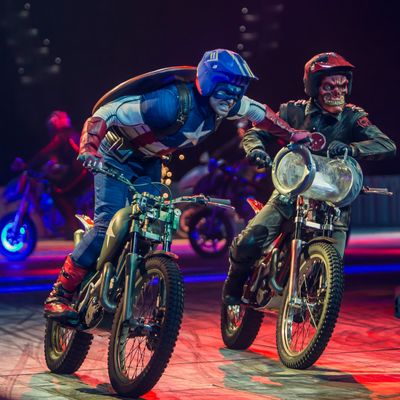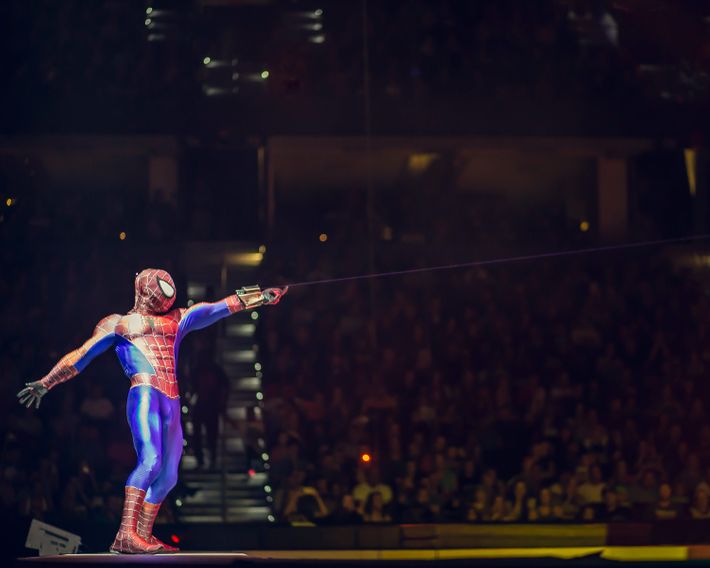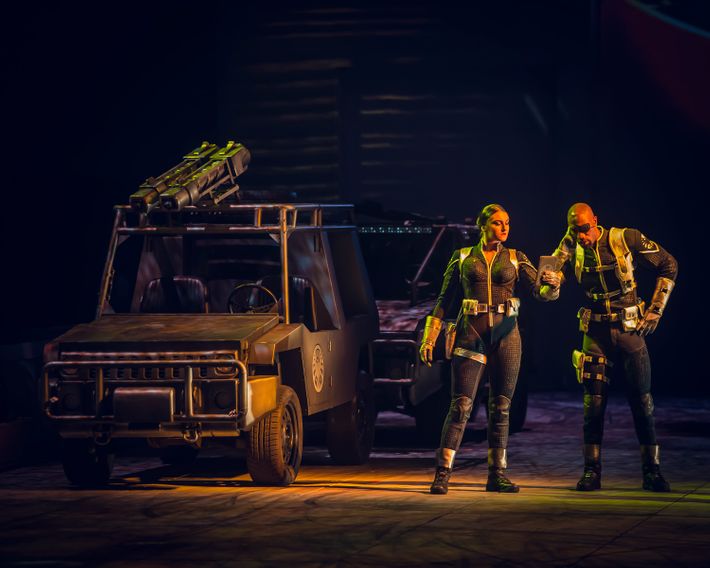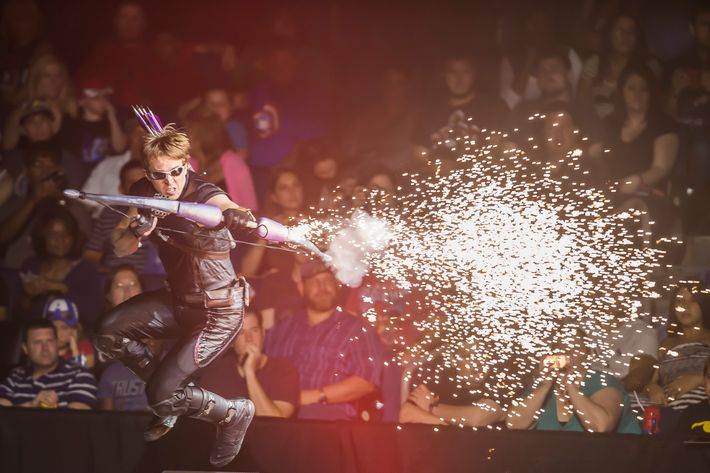
Marvel Universe Live! — a new “action-packed arena extravaganza” from Feld Entertainment, the company behind Disney on Ice, the Ringling Bros., and Barnum & Bailey Circus — is a disorienting, thought-provoking, deeply postmodern entertainment experience, even though it aims to be none of those things. With its skull-numbingly juvenile dialogue, flat characterization, and flimsy plot, the event is designed to excite preteens and distract their parents. It is, by any measure, silly. And yet, in spite of itself, this glorious mess, which kicks off a two-year worldwide tour tonight at Barclays Center in Brooklyn, is also an unintentional thesis statement about what Marvel is in 2014.
Don’t worry if this is the first you’re hearing of Marvel Universe Live!; you won’t need a whole lot of catching up to get the basic gist of what it’s about. The show stars a few dozen highly athletic performers dressed in the garb of iconic Marvel superheroes and villains, and, in service of a story that never gets more complicated than “a bunch of bad guys have stolen pieces of a magic weapon, so let’s steal them back,” they fly on wires, trigger pyrotechnics, perform choreographed fight sequences, ride motorcycles, and lip-synch to corny, prerecorded dialogue (sample line: “If he calls me a sidekick again, I’m going to kick him in the side!”). Here’s a video sample of the kind of goofiness you can see in Marvel Universe Live!, which I saw in a preview held recently in New Jersey: heroes Iron Man, Hawkeye, and Captain Marvel hopping around and beating up some evildoers who are amped up on superpower juice.
Few grown-up superhero enthusiasts or cultural critics will take any of this very seriously. But the show — which received creative input from Joe Quesada, the chief creative officer of Marvel Entertainment — inadvertently raises a huge question: What, exactly, is the “Marvel universe” right now? As of 2007, the answer would have been extremely simple: The Marvel universe is all of the interconnected stories and characters in Marvel Comics. Ever since the 1960s, Marvel has been committed to building a rich shared reality for all of its comics characters, from Wolverine to Captain America — a shared reality that superhero fans had pored over ad infinitum. It had a limited spectrum of “authors,” in the literary-theory sense of that word: the writers, artists, and editors of the comics. Sure, there had been scattered movies and TV shows, and some of those adaptations had been very successful (such as Sam Raimi’s Spider-Man trilogy and the X-Men cartoon of the 1990s). But no one would have considered that licensed material to be the heart of Marvel’s mythos, much less its driving force.
Then came the Day Everything Changed — May 2, 2008, when Marvel’s movie imprint, Marvel Studios, released Iron Man and launched what has come to be called the Marvel Cinematic Universe. Since then, Marvel Studios has built its own meticulous shared cosmology, full of interconnected references and complex continuity — and that cosmology has become far more powerful and profitable than the comics universe. Ask an average person to tell you about Tony Stark, and he or she will describe the cocky, partygoing sleazeball of the movies, not the mildly jokey former alcoholic who lives in the comics. (In fact, he or she might not have even known who Tony Stark was if you’d asked in 2007.) But the success of movies involving Marvel characters not controlled by Marvel Studios has also ripped apart certain portions of the intricate Marvel tapestry. Marvel Studios doesn’t own the movie rights to the massive A-list franchises Spider-Man, the X-Men, and the Fantastic Four, which has led to compromise and confusion. As an example, if you were to ask the aforementioned average person if Wolverine is a member of the Avengers, he or she would likely say no, even though Wolverine has been an Avenger in the comic books for years. And it would be tough to blame that person, since Wolverine has never met Iron Man in a movie and he very likely never will.

That’s just where the confusion begins, though. Seeing Marvel Studios’ success, Fox (which controls the X-Men and Fantastic Four film rights) and Sony (which owns the rights to Spider-Man) have followed suit by focusing on their own universe-building, full of spinoffs (see Sony’s upcoming Sinister Six) and continuity (e.g., all the head-numbing connections in X-Men: Days of Future Past). So, in short, there are currently three different Marvel cinematic universes. These competing efforts lead to bizarre developments, like the two completely unrelated movie versions of the character Quicksilver.
Just to make things even more complicated, Marvel has undergone some pretty radical thematic changes in its comics output in the past decade and a half. Marvel Comics has made an incredible push to highlight female characters and characters of color. Its in-house writing style isn’t as wordy, and it’s mostly banned thought bubbles. And, of course, the success of the movies has led it to do things like make comics versions of characters originally created for movies (such as S.H.I.E.L.D. agent Phil Coulson) or downplay characters it can’t seem to make movie money off of (such as the Fantastic Four, whom Fox is quixotically hoping to dredge out of box-office hell). There have long been parallel universes within Marvel Comics stories (“What if Magneto had taken over the world? This month, the X-Men step through an interdimensional portal and find out!”); but now we have, in a way, multiple Marvel universes throughout the entertainment industry — and this time, sadly, there can’t be any crossovers.
Which brings us back to Marvel Universe Live!. Right there in the title, it’s claiming to be a live version of something called the “Marvel Universe,” but what it gives us is not a live version of any one of the Marvel universes I’ve just listed. It tries to be a live version of all of the franchise universes. If you’re a casual viewer, you may not care about that distinction at all, but if you’re a nerd who cares about postmodernism, your brain will start to hurt.

Here’s just a taste of all the contradictions and influence-mixing in the live show. Right at the beginning, the show shatters the film-universe boundaries: Iron Man is hanging out in Avengers Tower when feisty teenage Spider-Man stops by for a visit. Now, of course, that happens all the time in the comics … but in the comics, Spider-Man hasn’t been a teenager in decades. So this isn’t the comics universe, either. They get a distress call from Nick Fury, who is African-American. That means he’s not the original comics version of Fury (who was white), but he’s also not the movie version of Nick Fury (who is African-American, but is a smooth-talker in a black trench coat; this Nick Fury is closer to Nick Fury Jr., an African-American character introduced to the comics as a result of the success of the movie version of Nick Fury). Nick Fury then fights aliens called the Chitauri, who only exist in the Marvel Cinematic Universe, although they share a name with a species that once appeared in an alternate-universe comics series. Wolverine is there, but the other X-Men only make brief cameos, and there’s no sign of the Fantastic Four — all of which plays into the comics-industry conspiracy theory that Marvel wants to downplay the characters whose film rights are owned by Fox because it has a bad profit-sharing deal with Fox.

All of that said, this freewheeling inter-universal mishmash can lead to a few moments of transcendence for a superhero addict. First and foremost is the inclusion of Avenger Carol Danvers in her role as Captain Marvel, a mantle she’s held only recently in her own comics title, and one she holds onstage in the amazing new costume she got when her series was launched in 2012. Progressive comics fans have clamored for Danvers to be used as Captain Marvel in a movie, to no avail, so her appearance here is cause for glee. And as lowbrow as it might be to say this, the motorcycle tricks are pretty rad!
I am, of course, overthinking this. Marvel Universe Live! is meant to be enjoyed, not analyzed. But part of the act of true comics love is attempting to pick apart the minutiae of a fictional universe, so I can’t help myself. This arena spectacle suggests that something revolutionary has occurred in the past six years: There is no such thing as “the Marvel universe” anymore. Once upon a time, there was such a thing, but it gave birth to a bunch of other Marvel universes — all of which are limited in breadth, but are growing independently and multiplying. No one entity has control over where it’s all heading; everything is up for grabs. Here’s a suggestion for a tagline Marvel Universe Live! might consider using: “The Marvel Universe Is Dead. Long Live the Marvel Universes.”

